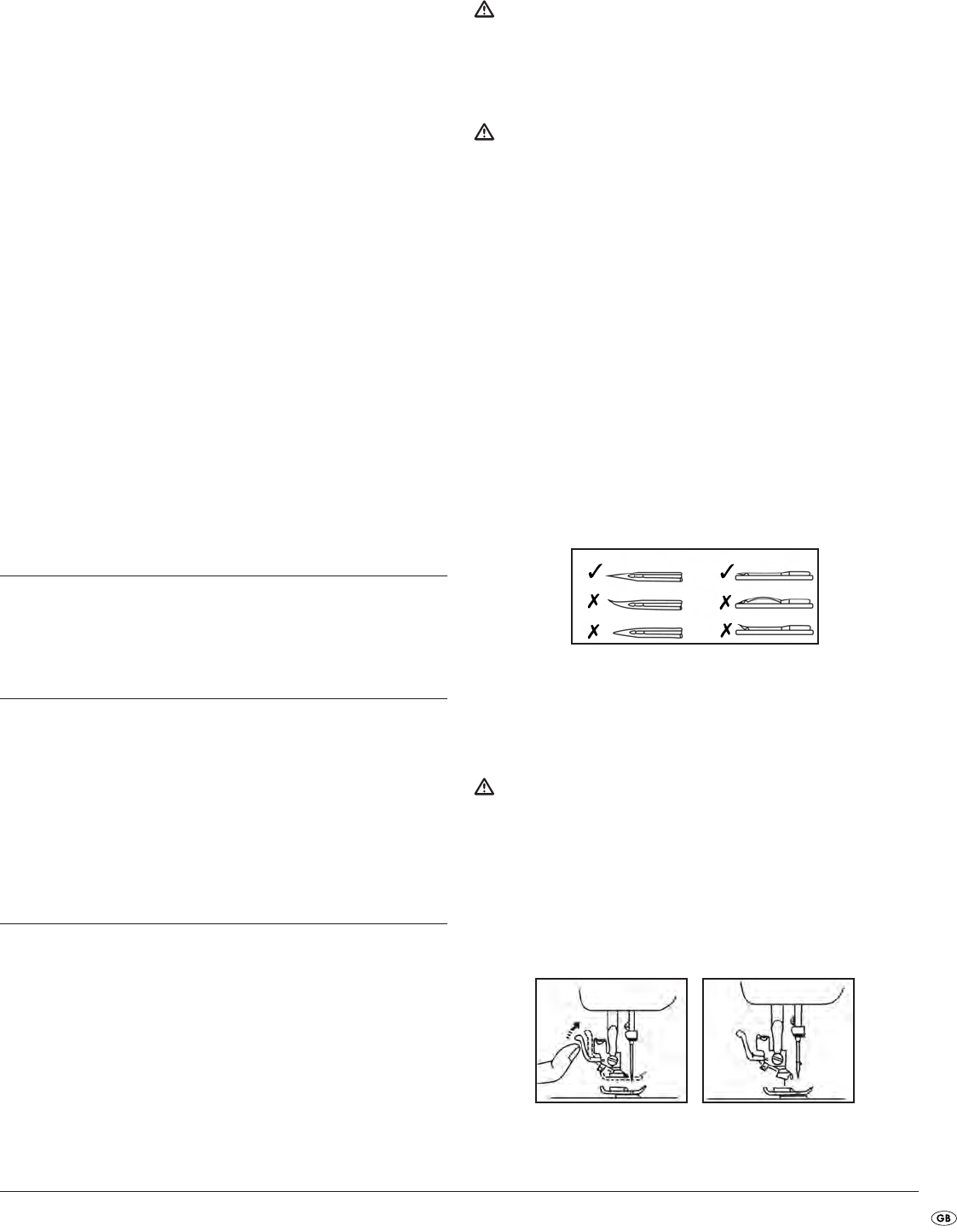
- 3 -
p
Sewing table extension with accessory compartment
a
Stitch plate
s
Sewing foot
d
Buttonhole lever
f
Needle retaining screw
g
Sewing foot lifting lever
h
Front cover
j
Thread takeover lever
k
Power plug
l
Foot pedal
y
Sewing machine plug
Accessories
x
small thread roll holder
c
large thread roll holder
v
Darning plate
b
additional thread spool carrier
n
Felt pads
m
4 bobbins
M
Sewing foot for sewing in zippers
N
Sewing foot for sewing buttonholes
B
Sewing foot for sewing on buttons
V
6 Sewing needles
C
Twin needle
X
Large screwdriver
Y
Small screwdriver
L
Protective cover
K
Sewing machine lubrication oil
J
Brush and thread cutter
H
Stitch plate opener
G
Threading aid
F
Blind hem foot
Setup
• Remove all packaging material from the appliance and the accessories.
• Put the sewing machine onto a stable, even and non-slip table.
Connecting the sewing machine
• Connect the plug of the sewing machine
y
with the box
e
on the
sewing machine.
• Insert the power plug
k
into a wall socket.
• Activate the power switch
r
in order to switch on the lighting of the
sewing machine.
The sewing machine is now ready for operation.
Operation of the sewing machine
Power switch
r
This switch is used
r
to switch the power supply and the lighting of the
sewing machine on and off.
• Set the power switch
r
at „I”, to switch the sewing machine on.
• Set the power switch
r
at „O”, to switch the sewing machine off.
Foot pedal
l
The machine will begin to sew at a slow speed as soon as the foot pedal
l
is gently activated. The sewing speed of the machine will increase when
more pressure is applied to the foot pedal
l
. The machine will stop running
when you take your foot from the pedal, as pressure is no longer being
applied to the pedal
l
.
Attention!
Ensure that you do not place any objects on the foot pedal
l
,
as this could lead to unintentional running of the machine.
Changing the sewing needles
Important
Remove the power plug
k
from the wall socket!
Otherwise the appliance could run unintentionally.
1. By turning the handwheel
0
bring the needle shank into the highest
possible position.
2. Apply pressure to the sewing foot lifting lever
g
so that the sewing
foot
s
is lowered onto the stitching plate
a
.
3. Remove the needle by loosening the retaining screw
f
.
4. Turn the new needle into a position whereby the flattened side of
the needle is pointing to the rear and insert the needle as far as it
will go into the needle clamp from below.
5. Tighten the retaining screw.
Checking the needle
1. Sewing needles must always be straight and, so that the sewing
procedure is smooth, must possess a faultless point.
2. Lay the flat side of the needle onto a smooth, even surface to check
if the needle is bent. This permits the easiest ascertainment of whether
the needle is bent or not.
3. Replace the needle whenever it is broken or blunt.
Changing the sewing foot
Dependant on the type of sewing you wish to carry out, it may be
necessary to exchange the sewing foot
s
.
Important
Remove the power plug
k
from the wall socket! If you do not,
the appliance could start to run unintentionally.
1. By turning the handwheel
0
(towards you, in an anti-clockwise direction)
bring the needle into the highest possible position and raise the sewing
foot lifting lever
g
and hence the foot bar.
2. Loosen the foot by carefully pressing the unlocking lever at the rear of
the spindle of the sewing foot upwards.
IB_KH4001_E2719_GB_LB4 23.04.2008 9:28 Uhr Seite 3


















